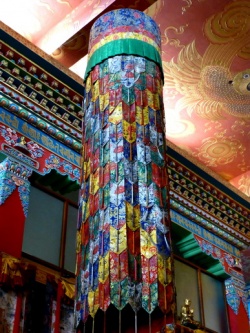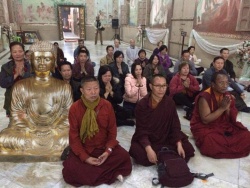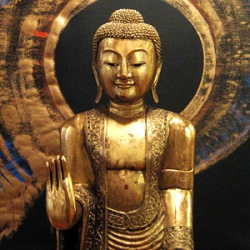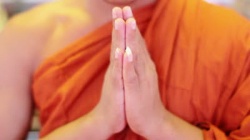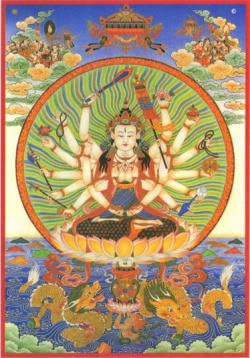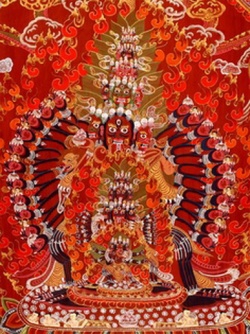Difference between revisions of "Jonang : Frequently Asked Questions (FAQ)"
(Created page with " 1) Q: Has the Jonang tradition continued in an unbroken lineage? A: Yes. In the 17th century, the Geluk power in {{Wiki|Central Tibet}} headed by the 5th Da...") |
|||
| (2 intermediate revisions by the same user not shown) | |||
| Line 1: | Line 1: | ||
| + | <nomobile>{{DisplayImages|3523|2538|619|1436|897|1776}}</nomobile> | ||
| + | 1) Q: Has the [[Jonang tradition]] continued in an unbroken [[lineage]]? | ||
| + | |||
| + | A: Yes. In the 17th century, the [[Geluk]] power in {{Wiki|Central Tibet}} headed by the [[5th Dalai Lama]] began a persecution of the [[Jonang]] due to {{Wiki|political}} rivalries and territorial struggles. | ||
| + | |||
| + | The [[Jonang tradition]] then relocated from {{Wiki|Central Tibet}} to the [[Amdo]] region of Far [[Eastern Tibet]], and has maintained an uninterrupted succession of [[transmission]] since the [[Buddha]]. | ||
| − | |||
| − | |||
2) Q: Was the persecution of the [[Jonang]] in the mid-17th century in {{Wiki|Central Tibet}} due to [[philosophical]] [[reasons]]? | 2) Q: Was the persecution of the [[Jonang]] in the mid-17th century in {{Wiki|Central Tibet}} due to [[philosophical]] [[reasons]]? | ||
| − | |||
| − | Due to conflicting territorial interests and struggles for power among the local {{Wiki|royal}} rulers of [[Tsang]] in {{Wiki|Central Tibet}}, the [[Jonang tradition]] found itself in [[opposition]] to the {{Wiki|political}} [[ambitions]] of the [[5th Dalai Lama]] and the {{Wiki|Mongols}}. Consequently, after the passing away of [[Taranatha]], the [[5th Dalai Lama]] forcefully converted [[Jonang Damcho Ling Monastery]] ([[Phuntsok Ling]]) and other [[Jonang | + | |
| + | A: No. The [[reason]] for the [[Geluk]] persecution of the [[Jonang]] during the mid-17th century in {{Wiki|Central Tibet}} was motivated entirely by {{Wiki|political}} interests. | ||
| + | |||
| + | The [[Fifth Dalai Lama]] was [[enthroned]] and backed by the {{Wiki|Mongol}} {{Wiki|Army}} who maintained control of {{Wiki|Central Tibet}} at that time. | ||
| + | |||
| + | |||
| + | |||
| + | Due to conflicting territorial interests and struggles for power among the local {{Wiki|royal}} rulers of [[Tsang]] in {{Wiki|Central Tibet}}, the [[Jonang tradition]] found itself in [[opposition]] to the {{Wiki|political}} [[ambitions]] of the [[5th Dalai Lama]] and the {{Wiki|Mongols}}. | ||
| + | |||
| + | Consequently, after the passing away of [[Taranatha]], the [[5th Dalai Lama]] forcefully converted [[Jonang Damcho Ling Monastery]] ([[Phuntsok Ling]]) and other [[Jonang monasteries]] into [[Geluk monasteries]], put a ban on [[zhentong]] teachings, sealed [[Jonang]] libraries, burnt texts on [[zhentong]], and the [[Jonang]] were forced to relocate away from their establishments in Central and [[Western Tibet]]. | ||
| + | |||
| + | |||
| + | |||
3) Q: Is there a ban on [[Jonang]] [[zhentong]] ("[[shentong]]") teachings? | 3) Q: Is there a ban on [[Jonang]] [[zhentong]] ("[[shentong]]") teachings? | ||
| − | A: No. In the year 1650, the [[5th Dalai Lama]] and the [[Tibetan]] Central Government sealed [[Jonang | + | A: No. In the year 1650, the [[5th Dalai Lama]] and the [[Tibetan]] Central Government sealed [[Jonang monasteries]] in {{Wiki|Central Tibet}} and placed a ban on the [[zhentong]] writings of the [[Jonang tradition]]. |
| + | |||
| + | The [[Jonang tradition]] then uprooted, and relocated to the [[Amdo]] region of Far [[Eastern Tibet]], outside the [[sphere]] of [[Geluk]] influence. Since the 17th century, there has not been a [[Geluk]] ban or prohibition against the [[Jonang]] or [[zhentong]] [[philosophical view]]. | ||
During the late 19th century, [[zhentong]] [[thought]] was revived and reintegrated into other [[traditions]] of [[Tibetan Buddhism]], specifically the [[Nyingma]] and [[Kagyu traditions]]. This was inspired by the [[Rime]] eclectic {{Wiki|movement}} and nonbiased approach to [[Tibetan Buddhist]] [[thought]] and practice. | During the late 19th century, [[zhentong]] [[thought]] was revived and reintegrated into other [[traditions]] of [[Tibetan Buddhism]], specifically the [[Nyingma]] and [[Kagyu traditions]]. This was inspired by the [[Rime]] eclectic {{Wiki|movement}} and nonbiased approach to [[Tibetan Buddhist]] [[thought]] and practice. | ||
The [[Jonang tradition]] has continued to refine and transmit its [[understanding]] of [[zhentong]] [[thinking]], and the [[zhentong]] [[realization]] of [[mind]] and [[reality]] derived from the [[Buddha's]] [[Essence]] [[Sutras]] and the [[Kalachakra Tantra]]. | The [[Jonang tradition]] has continued to refine and transmit its [[understanding]] of [[zhentong]] [[thinking]], and the [[zhentong]] [[realization]] of [[mind]] and [[reality]] derived from the [[Buddha's]] [[Essence]] [[Sutras]] and the [[Kalachakra Tantra]]. | ||
| + | |||
| + | |||
| + | |||
4) Q: Is the [[Jonang]] a sub-sect of the [[Sakya]] or [[Kagyu traditions]]? | 4) Q: Is the [[Jonang]] a sub-sect of the [[Sakya]] or [[Kagyu traditions]]? | ||
| − | A: No. There are five major living [[traditions]] of [[Tibetan Buddhism]]. [[Jonang]] mountain [[hermitage]] was established by [[Kunpang Thukje Tsondru]], and the [[Jonang tradition]] has remained an autonomous [[tradition]] of [[Tibetan Buddhism]] ever since. | + | |
| + | |||
| + | A: No. There are five major living [[traditions]] of [[Tibetan Buddhism]]. | ||
| + | |||
| + | [[Jonang]] mountain [[hermitage]] was established by [[Kunpang Thukje Tsondru]], and the [[Jonang tradition]] has remained an autonomous [[tradition]] of [[Tibetan Buddhism]] ever since. | ||
[[Dolpopa Sherab Gyaltsen]] trained at [[Sakya Monastery]] and met with the [[3rd Karmapa Rangjung Dorje]], he moved to [[Jonang]] in the year 1321 and later assumed [[leadership]] of [[Jonang Monastery]], helping to define the [[Jonang]] heritage of [[philosophy]] and practice. | [[Dolpopa Sherab Gyaltsen]] trained at [[Sakya Monastery]] and met with the [[3rd Karmapa Rangjung Dorje]], he moved to [[Jonang]] in the year 1321 and later assumed [[leadership]] of [[Jonang Monastery]], helping to define the [[Jonang]] heritage of [[philosophy]] and practice. | ||
| + | |||
| + | |||
| + | |||
5) Q: Were [[Yumo Mikyo Dorje]] or [[Kunkhyen Dolpopa Sherab Gyaltsen]] the founders of the [[Jonang tradition]]? | 5) Q: Were [[Yumo Mikyo Dorje]] or [[Kunkhyen Dolpopa Sherab Gyaltsen]] the founders of the [[Jonang tradition]]? | ||
| + | |||
| + | |||
A: No. [[Kunpang Thukje Tsondru]] established [[Jonang Monastery]] in the year 1294, {{Wiki|initiating}} what has become known as the "[[Jonang]]" [[tradition]]. | A: No. [[Kunpang Thukje Tsondru]] established [[Jonang Monastery]] in the year 1294, {{Wiki|initiating}} what has become known as the "[[Jonang]]" [[tradition]]. | ||
| − | [[Yumo Mikyo Dorje]] was a great 11th century [[yogi]], [[master]] of the [[Dro]] [[Kalachakra lineage]], and a forefather of the [[Jonang tradition]]. Among the early [[Jonang]] in [[Tibet]], he was among the first [[Tibetans]] to fully articulate what later became known as "[[tantric]] [[zhentong]]" derived from his [[realization]] of the [[Kalachakra]]. During the time of [[Yumo Mikyo Dorje]], there was no "[[Jonang]]" [[tradition]] as there is today. | + | [[Yumo Mikyo Dorje]] was a great 11th century [[yogi]], [[master]] of the [[Dro]] [[Kalachakra lineage]], and a forefather of the [[Jonang tradition]]. |
| + | |||
| + | Among the early [[Jonang]] in [[Tibet]], he was among the first [[Tibetans]] to fully articulate what later became known as "[[tantric]] [[zhentong]]" derived from his [[realization]] of the [[Kalachakra]]. | ||
| + | |||
| + | During the time of [[Yumo Mikyo Dorje]], there was no "[[Jonang]]" [[tradition]] as there is today. | ||
[[Dolpopa Sherab Gyaltsen]] was the 4rth [[Abbot]] of [[Jonang]] mountain [[hermitage]], and one of the great luminary figures of 14th century [[Tibet]]. His innovative works elucidating a [[zhentong]] view and the [[Kalachakra Tantra]] have become emblematic of [[Jonang]] [[thought]] and practice. | [[Dolpopa Sherab Gyaltsen]] was the 4rth [[Abbot]] of [[Jonang]] mountain [[hermitage]], and one of the great luminary figures of 14th century [[Tibet]]. His innovative works elucidating a [[zhentong]] view and the [[Kalachakra Tantra]] have become emblematic of [[Jonang]] [[thought]] and practice. | ||
| + | |||
| + | |||
6) Q: Was a [[zhentong]] view of [[reality]] [[taught]] by the [[Buddha]]? | 6) Q: Was a [[zhentong]] view of [[reality]] [[taught]] by the [[Buddha]]? | ||
| + | |||
| + | |||
A: Yes. The [[historical Buddha]] [[Shakyamuni]] [[taught]] 3 {{Wiki|distinct}} sets of [[sutra]] [[discourses]] or [[Three Turnings]] of the [[Dharma Wheel]]. Progressively, these three sets of [[discourses]] explain the [[Buddha's]] intended [[vision]] of [[reality]]. | A: Yes. The [[historical Buddha]] [[Shakyamuni]] [[taught]] 3 {{Wiki|distinct}} sets of [[sutra]] [[discourses]] or [[Three Turnings]] of the [[Dharma Wheel]]. Progressively, these three sets of [[discourses]] explain the [[Buddha's]] intended [[vision]] of [[reality]]. | ||
| − | While the initial and middle sets of the [[Buddha's]] [[discourses]] are regarded by the [[Jonang tradition]] as being provisional in meaning or [[subject]] to [[interpretation]], the [[Buddha's]] final set of [[discourses]] are regarded as [[definitive in meaning]]. This final set of [[discourses]] or turning consists of the ten [[Essence]] [[Sutras]] that clearly elucidate a [[zhentong]] view. Other [[Tibetan Buddhist]] interpretations of the [[Buddha's teachings]] assert a [[rangtong]] view, taking the [[Buddha's]] middle set of [[discourses]] as definitive. | + | While the initial and middle sets of the [[Buddha's]] [[discourses]] are regarded by the [[Jonang tradition]] as being provisional in meaning or [[subject]] to [[interpretation]], the [[Buddha's]] final set of [[discourses]] are regarded as [[definitive in meaning]]. |
| + | |||
| + | This final set of [[discourses]] or turning consists of the ten [[Essence]] [[Sutras]] that clearly elucidate a [[zhentong]] view. Other [[Tibetan Buddhist]] interpretations of the [[Buddha's teachings]] assert a [[rangtong]] view, taking the [[Buddha's]] middle set of [[discourses]] as definitive. | ||
| + | |||
| + | |||
| + | |||
7) Q: Does the [[Jonang tradition]] maintain the entire [[Kalachakra tantric practice]]? | 7) Q: Does the [[Jonang tradition]] maintain the entire [[Kalachakra tantric practice]]? | ||
| − | |||
| − | Due to historical circumstance, the [[6-fold vajrayoga]] of the [[Kalachakra completion stage]] practice have not been fully sustained and elaborated by any of the [[traditions]] of [[Tibetan Buddhism]] except for the [[Jonang]]. Placing extreme importance on, and {{Wiki|emphasizing}} the practice of the vajrayoga, the [[Jonang tradition]] has preserved this unique [[tantric practice]] [[lineage]] and its guidance instructions. | + | |
| + | A: Yes. The [[Jonang tradition]] holds the entire [[practice lineage]] of the [[Kalachakra Tantra]], [[including]] the [[Kalachakra completion stage]] practices of vajrayoga. | ||
| + | |||
| + | Due to historical circumstance, the [[6-fold vajrayoga]] of the [[Kalachakra completion stage]] practice have not been fully sustained and elaborated by any of the [[traditions]] of [[Tibetan Buddhism]] except for the [[Jonang]]. | ||
| + | |||
| + | Placing extreme importance on, and {{Wiki|emphasizing}} the practice of the vajrayoga, the [[Jonang tradition]] has preserved this unique [[tantric practice]] [[lineage]] and its guidance instructions. | ||
8) Q: Who is the "head" or "leader" of the [[Jonangpa]]? | 8) Q: Who is the "head" or "leader" of the [[Jonangpa]]? | ||
| − | A: There is no official "head." For the initial 300-years of the [[Jonangpa]], the primary lineage-heir was the [[master]] who held the seat of [[Jomonang]] and then later [[Taranatha's]] [[Takten Damcho Ling]] [[Monastery]] ([[Phuntsok Ling]]). In the mid-17 th century, when the [[Jonangpa]] began to settle in the [[Amdo]] region of Northeastern [[Tibet]], [[Dzamthang Tsangwa Monastery]] was founded by one of [[Taranatha's]] [[disciples]] [[Lodro Namgyal]], transferring the [[spiritual]] authority to [[Dzamthang]]. Since the [[Jonangpa]] have stationed in [[Amdo]], and since [[Dzamthang]] has become their headquarters, although the [[spiritual]] authority of the [[Jonang]] has not rested on one {{Wiki|individual}}, the [[abbot]] of [[Dzamthang Tsangwa Monastery]] has historically held great authority and influence within the [[tradition]]. | + | A: There is no official "head." For the initial 300-years of the [[Jonangpa]], the primary lineage-heir was the [[master]] who held the seat of [[Jomonang]] and then later [[Taranatha's]] [[Takten Damcho Ling]] [[Monastery]] ([[Phuntsok Ling]]). |
| + | |||
| + | In the mid-17 th century, when the [[Jonangpa]] began to settle in the [[Amdo]] region of Northeastern [[Tibet]], [[Dzamthang Tsangwa Monastery]] was founded by one of [[Taranatha's]] [[disciples]] [[Lodro Namgyal]], transferring the [[spiritual]] authority to [[Dzamthang]]. | ||
| + | |||
| + | Since the [[Jonangpa]] have stationed in [[Amdo]], and since [[Dzamthang]] has become their headquarters, although the [[spiritual]] authority of the [[Jonang]] has not rested on one {{Wiki|individual}}, the [[abbot]] of [[Dzamthang Tsangwa Monastery]] has historically held great authority and influence within the [[tradition]]. | ||
| + | |||
| + | One of [[Jetsun Taranatha's]] [[reincarnations]] lines finds its origins in [[Mongolia]] when the [[5th Dalai Lama]] [[recognized]] the 1st [[Kalkha Jetsun Dhampa]]. | ||
| + | |||
| + | More recently, [[His Holiness the 14th Dalai Lama]] appointed the [[9th Kalkha Rinpoche]] to oversee the affairs of the [[Jonang monastery]] in {{Wiki|Shimla}}, [[India]] called, "[[Takten Phuntsok Choling]]." | ||
| − | + | [[Kalkha Jetsun Dhampa]] is considered to be the authoritative figure for the [[Jonangpa]] in exile and more specifically in [[India]] where he [[lives]]. Unfortunately, [[Kalkha Rinpoche]] has not been permitted to travel to [[Tibet]] since he left as a young man and consequently he is not known by many of the [[Jonangpa]] in [[Tibet]]. | |
Most recently, the [[Jonang Standing Council]] was formed by the elder [[Jonang]] [[masters]] in [[Tibet]] in order to create a greater {{Wiki|structure}} of authority and [[leadership]]. We at [[Jonang Foundation]] are representatives of this Council and we work closely with its leaders to assist the [[Jonang]] in [[Tibet]] and elsewhere. | Most recently, the [[Jonang Standing Council]] was formed by the elder [[Jonang]] [[masters]] in [[Tibet]] in order to create a greater {{Wiki|structure}} of authority and [[leadership]]. We at [[Jonang Foundation]] are representatives of this Council and we work closely with its leaders to assist the [[Jonang]] in [[Tibet]] and elsewhere. | ||
Latest revision as of 10:14, 10 February 2017
1) Q: Has the Jonang tradition continued in an unbroken lineage?
A: Yes. In the 17th century, the Geluk power in Central Tibet headed by the 5th Dalai Lama began a persecution of the Jonang due to political rivalries and territorial struggles.
The Jonang tradition then relocated from Central Tibet to the Amdo region of Far Eastern Tibet, and has maintained an uninterrupted succession of transmission since the Buddha.
2) Q: Was the persecution of the Jonang in the mid-17th century in Central Tibet due to philosophical reasons?
A: No. The reason for the Geluk persecution of the Jonang during the mid-17th century in Central Tibet was motivated entirely by political interests.
The Fifth Dalai Lama was enthroned and backed by the Mongol Army who maintained control of Central Tibet at that time.
Due to conflicting territorial interests and struggles for power among the local royal rulers of Tsang in Central Tibet, the Jonang tradition found itself in opposition to the political ambitions of the 5th Dalai Lama and the Mongols.
Consequently, after the passing away of Taranatha, the 5th Dalai Lama forcefully converted Jonang Damcho Ling Monastery (Phuntsok Ling) and other Jonang monasteries into Geluk monasteries, put a ban on zhentong teachings, sealed Jonang libraries, burnt texts on zhentong, and the Jonang were forced to relocate away from their establishments in Central and Western Tibet.
3) Q: Is there a ban on Jonang zhentong ("shentong") teachings?
A: No. In the year 1650, the 5th Dalai Lama and the Tibetan Central Government sealed Jonang monasteries in Central Tibet and placed a ban on the zhentong writings of the Jonang tradition.
The Jonang tradition then uprooted, and relocated to the Amdo region of Far Eastern Tibet, outside the sphere of Geluk influence. Since the 17th century, there has not been a Geluk ban or prohibition against the Jonang or zhentong philosophical view.
During the late 19th century, zhentong thought was revived and reintegrated into other traditions of Tibetan Buddhism, specifically the Nyingma and Kagyu traditions. This was inspired by the Rime eclectic movement and nonbiased approach to Tibetan Buddhist thought and practice.
The Jonang tradition has continued to refine and transmit its understanding of zhentong thinking, and the zhentong realization of mind and reality derived from the Buddha's Essence Sutras and the Kalachakra Tantra.
4) Q: Is the Jonang a sub-sect of the Sakya or Kagyu traditions?
A: No. There are five major living traditions of Tibetan Buddhism.
Jonang mountain hermitage was established by Kunpang Thukje Tsondru, and the Jonang tradition has remained an autonomous tradition of Tibetan Buddhism ever since.
Dolpopa Sherab Gyaltsen trained at Sakya Monastery and met with the 3rd Karmapa Rangjung Dorje, he moved to Jonang in the year 1321 and later assumed leadership of Jonang Monastery, helping to define the Jonang heritage of philosophy and practice.
5) Q: Were Yumo Mikyo Dorje or Kunkhyen Dolpopa Sherab Gyaltsen the founders of the Jonang tradition?
A: No. Kunpang Thukje Tsondru established Jonang Monastery in the year 1294, initiating what has become known as the "Jonang" tradition.
Yumo Mikyo Dorje was a great 11th century yogi, master of the Dro Kalachakra lineage, and a forefather of the Jonang tradition.
Among the early Jonang in Tibet, he was among the first Tibetans to fully articulate what later became known as "tantric zhentong" derived from his realization of the Kalachakra.
During the time of Yumo Mikyo Dorje, there was no "Jonang" tradition as there is today.
Dolpopa Sherab Gyaltsen was the 4rth Abbot of Jonang mountain hermitage, and one of the great luminary figures of 14th century Tibet. His innovative works elucidating a zhentong view and the Kalachakra Tantra have become emblematic of Jonang thought and practice.
6) Q: Was a zhentong view of reality taught by the Buddha?
A: Yes. The historical Buddha Shakyamuni taught 3 distinct sets of sutra discourses or Three Turnings of the Dharma Wheel. Progressively, these three sets of discourses explain the Buddha's intended vision of reality.
While the initial and middle sets of the Buddha's discourses are regarded by the Jonang tradition as being provisional in meaning or subject to interpretation, the Buddha's final set of discourses are regarded as definitive in meaning.
This final set of discourses or turning consists of the ten Essence Sutras that clearly elucidate a zhentong view. Other Tibetan Buddhist interpretations of the Buddha's teachings assert a rangtong view, taking the Buddha's middle set of discourses as definitive.
7) Q: Does the Jonang tradition maintain the entire Kalachakra tantric practice?
A: Yes. The Jonang tradition holds the entire practice lineage of the Kalachakra Tantra, including the Kalachakra completion stage practices of vajrayoga.
Due to historical circumstance, the 6-fold vajrayoga of the Kalachakra completion stage practice have not been fully sustained and elaborated by any of the traditions of Tibetan Buddhism except for the Jonang.
Placing extreme importance on, and emphasizing the practice of the vajrayoga, the Jonang tradition has preserved this unique tantric practice lineage and its guidance instructions.
8) Q: Who is the "head" or "leader" of the Jonangpa?
A: There is no official "head." For the initial 300-years of the Jonangpa, the primary lineage-heir was the master who held the seat of Jomonang and then later Taranatha's Takten Damcho Ling Monastery (Phuntsok Ling).
In the mid-17 th century, when the Jonangpa began to settle in the Amdo region of Northeastern Tibet, Dzamthang Tsangwa Monastery was founded by one of Taranatha's disciples Lodro Namgyal, transferring the spiritual authority to Dzamthang.
Since the Jonangpa have stationed in Amdo, and since Dzamthang has become their headquarters, although the spiritual authority of the Jonang has not rested on one individual, the abbot of Dzamthang Tsangwa Monastery has historically held great authority and influence within the tradition.
One of Jetsun Taranatha's reincarnations lines finds its origins in Mongolia when the 5th Dalai Lama recognized the 1st Kalkha Jetsun Dhampa.
More recently, His Holiness the 14th Dalai Lama appointed the 9th Kalkha Rinpoche to oversee the affairs of the Jonang monastery in Shimla, India called, "Takten Phuntsok Choling."
Kalkha Jetsun Dhampa is considered to be the authoritative figure for the Jonangpa in exile and more specifically in India where he lives. Unfortunately, Kalkha Rinpoche has not been permitted to travel to Tibet since he left as a young man and consequently he is not known by many of the Jonangpa in Tibet.
Most recently, the Jonang Standing Council was formed by the elder Jonang masters in Tibet in order to create a greater structure of authority and leadership. We at Jonang Foundation are representatives of this Council and we work closely with its leaders to assist the Jonang in Tibet and elsewhere.
